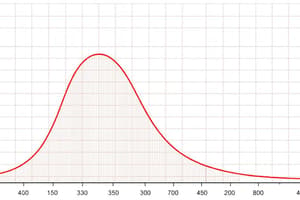Podcast
Questions and Answers
What does STAT PLOTS allow you to show?
What does STAT PLOTS allow you to show?
- Scatterplots
- Histograms
- Boxplots
- All of the above (correct)
What is the purpose of the STAT PLOT w/ TRACE function?
What is the purpose of the STAT PLOT w/ TRACE function?
It traces the plots.
What do 1-Var Stats provide?
What do 1-Var Stats provide?
Mean, Standard Deviation, and 5-number summary.
What does binompdf (n, p, x) calculate?
What does binompdf (n, p, x) calculate?
What does binomcdf (n, p, x) compute?
What does binomcdf (n, p, x) compute?
What does geometpdf (p, x) measure?
What does geometpdf (p, x) measure?
What does geometcdf (p, x) return?
What does geometcdf (p, x) return?
What does normalcdf (lowerbound, upperbound, mean, SD) calculate?
What does normalcdf (lowerbound, upperbound, mean, SD) calculate?
What does InvNorm (area, mean, SD) provide?
What does InvNorm (area, mean, SD) provide?
What does tcdf (lowerbound, upperbound, df) yield?
What does tcdf (lowerbound, upperbound, df) yield?
What does invT(area, df) provide?
What does invT(area, df) provide?
What does X (squared) cdf (lowerbound, upperbound, df) compute?
What does X (squared) cdf (lowerbound, upperbound, df) compute?
What does X (squared) GOF-Test accomplish?
What does X (squared) GOF-Test accomplish?
What does LinReg (a*x + b) do?
What does LinReg (a*x + b) do?
What is displayed when DiagnosticOn is activated?
What is displayed when DiagnosticOn is activated?
What does 1-PropZInt provide?
What does 1-PropZInt provide?
What does 2-PropZInt calculate?
What does 2-PropZInt calculate?
What does TInterval yield?
What does TInterval yield?
What does 2-SampTInt compute?
What does 2-SampTInt compute?
What does 1-PropZTest do?
What does 1-PropZTest do?
What is the purpose of a T-Test?
What is the purpose of a T-Test?
What does 2-PropZTest compare?
What does 2-PropZTest compare?
What does x-squared test determine?
What does x-squared test determine?
What does LinRegTTest perform?
What does LinRegTTest perform?
Flashcards are hidden until you start studying
Study Notes
Calculator Functions in AP Statistics
-
STAT PLOTS: Enable visualization of data through scatterplots, histograms, boxplots, and modified boxplots.
-
STAT PLOT w/ TRACE: Allows tracing along plotted graphs for validation or exploration.
-
1-Var Stats: Provides essential statistical measures including mean, standard deviation (SD), and five-number summary (5-numsum).
-
binompdf (n, p, x): Computes the probability of achieving exactly x successes in n trials, with p denoting success probability.
-
binomcdf (n, p, x): Calculates the cumulative probability of obtaining x or fewer successes in a series of trials.
-
geometpdf (p, x): Determines the probability that the first success occurs on the x-th trial, where p is the probability of success on each trial.
-
geometcdf (p, x): Gives cumulative probability that the first success happens on or before the x-th trial.
-
normalcdf (lower bound, upper bound, mean, SD): Evaluates the probability that a score falls between a specified lower and upper bound, given a certain mean and SD.
-
InvNorm (area, mean, SD): Finds the score corresponding to a specified area (probability) under a normal distribution curve, determined by the given mean and SD.
-
tcdf (lower bound, upper bound, df): Computes the probability that a score lies within two bounds for a chosen degrees of freedom (df).
-
invT(area, df): Identifies the t-score linked to an area (probability) to the left under the Student's t-distribution curve for specified df.
-
X² cdf (lower bound, upper bound, df): Calculates the probability that a score lies between two bounds for a specific degrees of freedom related to chi-square distribution.
-
X² GOF-Test: Executes a chi-square goodness-of-fit test to assess if sample data fits a specific distribution.
-
LinReg (ax + b): Fits a linear equation y = ax + b to data from lists L1 and L2, utilizing least squares fitting method.
-
DiagnosticOn: Activates the display of r-squared and correlation coefficient (r) in the linear regression output.
-
1-PropZInt: Provides a confidence interval for the proportion of successes in a single population.
-
2-PropZInt: Calculates a confidence interval for the difference between two population proportions.
-
TInterval: Generates a confidence interval for the mean, comparing proportions of successes.
-
2-SampTInt: Computes a confidence interval for the difference between the means of two populations.
-
1-PropZTest: Conducts a hypothesis test for a proportion to evaluate significance.
-
T-Test: A hypothesis test to compare means.
-
2-SampTTest: Similar to T-Test but for two separate samples' means.
-
2-PropZTest: Hypothesis test for comparing proportions between two populations, utilizing a pooled sample proportion.
-
x-squared test: Provides the chi-squared value and p-value for testing the null hypothesis (H0) of no association between categorical variables.
-
LinRegTTest: Applies linear regression to test the null hypothesis (H0: B = 0), with the regression output stored in RegEQ and residuals in RESID.
Studying That Suits You
Use AI to generate personalized quizzes and flashcards to suit your learning preferences.




